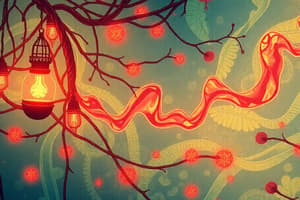Podcast
Questions and Answers
What primarily causes central cyanosis?
What primarily causes central cyanosis?
- High levels of oxygen dissolved in plasma
- Increased oxygen saturation in peripheral tissues
- Reduced arterial oxygen saturation due to cardiopulmonary diseases (correct)
- Vasoconstriction in the extremities
In which area is cyanosis most easily identified?
In which area is cyanosis most easily identified?
- The abdomen
- The scalp
- The dorsal surface of the hand
- The nasal planum (correct)
Which form of oxygen transport constitutes the majority in the blood?
Which form of oxygen transport constitutes the majority in the blood?
- Bound to hemoglobin (correct)
- Converted to bicarbonate
- Dissolved in plasma
- Transported by white blood cells
What leads to peripheral cyanosis?
What leads to peripheral cyanosis?
What is the normal range for arterial oxygen tension (PaO2) in an individual breathing room air?
What is the normal range for arterial oxygen tension (PaO2) in an individual breathing room air?
Flashcards are hidden until you start studying
Study Notes
Cyanosis
- Cyanosis is a blue discoloration of the skin caused by high levels of deoxygenated hemoglobin in the blood.
- It's easily noticeable in areas with a lot of blood vessels near the surface and thin skin.
- The word "cyanosis" comes from the Greek word kuaneos meaning dark blue.
- There are two types of cyanosis: central and peripheral.
- Central cyanosis is more common and caused by low oxygen levels in the blood (hypoxemia) due to lung or heart problems or blood disorders.
- Peripheral cyanosis is caused by reduced blood flow to the extremities, often due to cold temperatures or vasoconstriction.
- Oxygen is carried in the blood in two ways: dissolved in plasma and bound to hemoglobin.
- Normal arterial oxygen tension (PaO2) in someone breathing room air at sea level is between 80-100 mm Hg.
- Only 1-2% of the total oxygen in the blood is dissolved, measured by PaO2.
- Most oxygen in the blood is bound to hemoglobin. The amount of oxygen bound to hemoglobin is determined by the PaO2, which is represented by the oxygen dissociation curve.
- Hypoxemia is a condition where the oxygen saturation of the blood (SaO2) is below 90%.
Studying That Suits You
Use AI to generate personalized quizzes and flashcards to suit your learning preferences.




